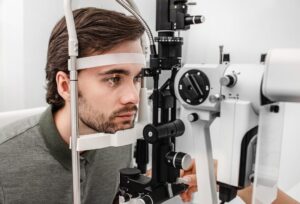Table of Contents
ToggleLASIK surgery, or Laser-Assisted In Situ Keratomileusis, is a popular procedure that promises to reduce or eliminate the need for glasses and contact lenses. Despite its rising popularity, several myths and misconceptions surround the surgery, leading many individuals to question its overall worth. This article aims to explore the realities of LASIK surgery by breaking down its procedure, analyzing its benefits, debunking common myths, addressing key misconceptions, and guiding potential patients in making informed decisions.
Understanding LASIK Surgery
What is LASIK Surgery?
LASIK surgery is a refractive surgical procedure designed to correct vision problems, particularly myopia (nearsightedness), hyperopia (farsightedness), and astigmatism. It utilizes a special laser to reshape the cornea, the transparent front part of the eye, so that light entering the eye can be focused more precisely on the retina.
Since its introduction in the 1990s, LASIK has gained widespread recognition and acceptance among patients seeking a long-term solution to visual impairments. The procedure is typically performed on an outpatient basis and requires little to no downtime, making it an appealing option for many individuals. Moreover, advancements in technology have led to the development of various LASIK techniques, such as wavefront-guided LASIK, which tailors the treatment to the unique imperfections of each patient’s eye, potentially enhancing the quality of vision even further.

The Procedure of LASIK Surgery
The LASIK procedure involves several critical steps, each designed to ensure the patient’s safety and comfort. Initially, the ophthalmologist will conduct a thorough eye examination to determine if the patient is a suitable candidate for the surgery. If deemed eligible, the procedure generally follows these steps:
Anesthesia: The patient receives numbing eye drops to minimize discomfort during the procedure.
Creating a Corneal Flap: A microkeratome or a femtosecond laser is used to create a thin flap in the cornea, which is then gently lifted to expose the underlying corneal tissue.
Laser Reshaping: An excimer laser is used to remove precise amounts of corneal tissue to alter its shape, allowing light to focus more accurately on the retina.
Repositioning the Flap: The corneal flap is then carefully laid back into place, where it adheres naturally without the need for stitches.
The entire procedure typically lasts about 15 minutes per eye, and many patients report seeing improvement in their vision almost immediately. Post-operative care is also crucial; patients are usually prescribed antibiotic and anti-inflammatory eye drops to prevent infection and promote healing. Regular follow-up appointments are scheduled to monitor the recovery process and ensure optimal results, allowing the ophthalmologist to address any concerns that may arise during the healing phase.
It’s important to note that while LASIK has a high success rate, not everyone is a suitable candidate for the surgery. Factors such as age, eye health, and the degree of refractive error play significant roles in determining eligibility. Patients with certain conditions, like severe dry eyes or thin corneas, may need to explore alternative vision correction options. Thus, a comprehensive consultation with an experienced ophthalmologist is essential to discuss the potential risks and benefits, ensuring that patients make informed decisions regarding their vision correction journey.
Evaluating the Worth of LASIK Surgery
Cost-Benefit Analysis of LASIK Surgery
When pondering the worth of LASIK surgery, it’s essential to conduct a cost-benefit analysis. The average cost of LASIK varies widely depending on factors such as geographic location, the technology used, and the surgeon’s expertise. Patients can expect to pay anywhere from $2,000 to $3,000 per eye.
While the initial cost may seem high, many individuals find that LASIK offers significant long-term savings compared to the recurring expenses of glasses and contact lenses. Over a decade, the cumulative costs of these vision correction methods can surpass the one-time expense of LASIK. Furthermore, many insurance plans do not cover corrective lenses, making the financial burden even more substantial for those who rely on them. By investing in LASIK, patients can potentially eliminate the need for frequent lens replacements, cleaning solutions, and the ongoing costs associated with eye care visits for prescriptions.
Long-Term Benefits of LASIK Surgery
Beyond financial considerations, LASIK provides various long-term benefits, including:
Improved Quality of Life: The ability to see clearly without glasses or contacts enhances day-to-day activities, such as sports, travel, and even spontaneous outings.
Freedom from Dependency: Many people value the independence that comes with LASIK, as they no longer need to rely on corrective lenses.
Stable Vision Correction: LASIK generally provides a permanent solution to refractive errors, although some individuals may experience slight changes in their vision as they age.
Additionally, LASIK can significantly boost self-esteem and confidence. Many patients report feeling more attractive and self-assured without the need for glasses, which can sometimes be perceived as a hindrance to one’s appearance. This newfound confidence can extend beyond personal interactions, positively influencing professional opportunities and social engagements. Moreover, the convenience of waking up with clear vision can transform daily routines, allowing individuals to engage in activities like swimming or hiking without the hassle of managing corrective lenses. The freedom to participate in spontaneous adventures, without the worry of forgetting glasses or running out of contact lenses, adds an enriching layer to life experiences. Read more about Eyeglasses and contact lenses at https://www.urmc.rochester.edu/encyclopedia/content.aspx?ContentTypeID=90&ContentID=P02089
Another noteworthy aspect of LASIK is its rapid recovery time. Most patients experience improved vision almost immediately after the procedure, with many returning to regular activities within a day or two. This quick turnaround is particularly appealing for those with busy lifestyles, as it minimizes downtime and allows for a smoother transition back to daily routines. The advancements in technology, such as wavefront-guided LASIK and femtosecond lasers, have further enhanced the safety and efficiency of the procedure, making it a more attractive option for those considering vision correction.
Debunking Common Myths about LASIK Surgery
Myth 1: LASIK Surgery is Painful
One of the most persistent myths surrounding LASIK surgery is that the procedure is painful. In reality, the use of numbing eye drops ensures that patients experience minimal discomfort during the operation.
Post-operative discomfort is typically mild and manageable, often described as a feeling of dryness or grittiness. Most patients can resume their regular activities within a day or two, making the pain myth significantly exaggerated.
Furthermore, the surgical environment is designed to be as comfortable as possible, with many clinics providing soothing music and a calming atmosphere to help ease any anxiety. Surgeons are also trained to communicate with patients throughout the procedure, ensuring they feel informed and at ease. This careful attention to patient comfort helps to dispel fears and misconceptions about pain associated with LASIK.
Myth 2: LASIK Surgery Results are Temporary
Another common misconception is that the results of LASIK surgery are temporary and that patients will eventually need glasses or contacts again. While it is true that some individuals may experience vision changes later in life due to age-related conditions like presbyopia, LASIK surgery itself often results in stable vision correction for many years.
Additionally, advancements in LASIK technology and techniques continue to enhance the durability of its outcomes. For instance, newer methods such as wavefront-guided LASIK provide a more personalized treatment by mapping the unique imperfections in a patient’s eyes, leading to sharper vision and a lower likelihood of regression. As a result, many patients enjoy the freedom from corrective lenses for decades, with numerous studies indicating that over 90% of patients achieve 20/25 vision or better after the procedure. To learn more about what to expect after lasik surgery click here.
Addressing Common Misconceptions about LASIK Surgery
Misconception 1: Everyone is a Suitable Candidate for LASIK Surgery
Not everyone can undergo LASIK surgery. Potential candidates must meet specific criteria, including the degree of refractive error, age, and overall eye health. Individuals with certain conditions, such as severe dry eye, corneal diseases, or a history of vision instability, may not qualify for the procedure.
A comprehensive evaluation by an experienced eye care professional is necessary to determine the suitability of LASIK for each individual. This evaluation often includes detailed tests to assess the thickness of the cornea, the shape of the eye, and the overall health of the retina. Additionally, factors such as hormonal changes, medications, and lifestyle choices can influence candidacy. For instance, individuals who are pregnant or nursing may need to wait until their hormone levels stabilize before considering LASIK, as these fluctuations can affect vision stability.
Misconception 2: LASIK Surgery Guarantees Perfect Vision
While LASIK surgery can drastically improve vision, it does not guarantee perfect eyesight. The goal of the procedure is to reduce dependency on corrective lenses and enhance visual acuity. Most patients achieve 20/25 vision or better, which is sufficient for most daily activities.
However, each patient’s results may vary depending on their unique circumstances, and some may still require glasses for specific tasks, such as reading or night driving. It’s also important to note that vision can change over time due to factors like aging or the development of cataracts. Therefore, patients should maintain realistic expectations and understand that follow-up care and potential enhancements may be necessary to achieve optimal vision over the years. Moreover, advancements in laser technology and surgical techniques continue to evolve, providing patients with improved outcomes and options tailored to their specific needs.

Making an Informed Decision about LASIK Surgery
Factors to Consider Before Opting for LASIK Surgery
Before deciding on LASIK surgery, several factors should be taken into account:
Vision Correction Needs: Assessing personal vision goals is crucial to understanding if LASIK is the right fit.
Health Conditions: Disclose any existing medical conditions that could impact the surgery’s success.
Recovery Time: Consider the time available for recovery, as some individuals may need a few days off to adjust post-surgery.
In addition to these considerations, it is essential to evaluate your lifestyle and daily activities. For instance, individuals who engage in contact sports or have jobs that require a high degree of visual acuity may benefit significantly from LASIK. Understanding how your vision affects your day-to-day life can provide further clarity on whether the procedure aligns with your personal and professional aspirations. Furthermore, potential candidates should also consider the long-term effects of LASIK, including the possibility of needing glasses or contacts later in life, as well as the potential for changes in vision due to aging.
Consulting with a Professional: The Key to a Successful LASIK Surgery
The most critical step before undergoing LASIK surgery is consulting with a qualified ophthalmologist. A comprehensive pre-operative examination can help ensure a clear understanding of the risks, benefits, and realistic outcomes of the procedure. An experienced surgeon can guide candidates through the decision-making process and tailor the approach based on individual needs.
During this consultation, patients should feel empowered to ask questions about the technology used, the surgeon’s experience, and the specifics of the procedure itself. Understanding the different types of LASIK techniques, such as wavefront-guided LASIK or femtosecond laser LASIK, can also help patients make more informed choices. Moreover, discussing potential side effects and post-operative care is vital for setting realistic expectations. This dialogue not only fosters trust but also ensures that patients are fully informed about what to expect before, during, and after the surgery.
Ultimately, while LASIK surgery offers a promising solution to refractive errors, potential patients should weigh the associated factors, clarify common myths, and consult professionals to make an informed and confident decision.
Related : Exploring the Benefits of Surgery LASIK: A Modern Approach to Vision Correction




